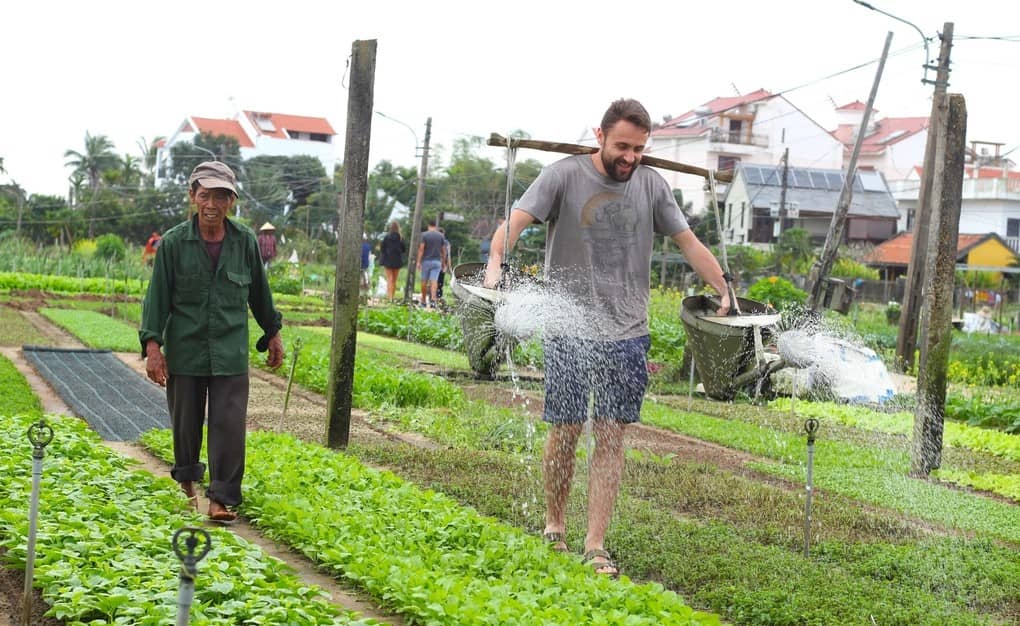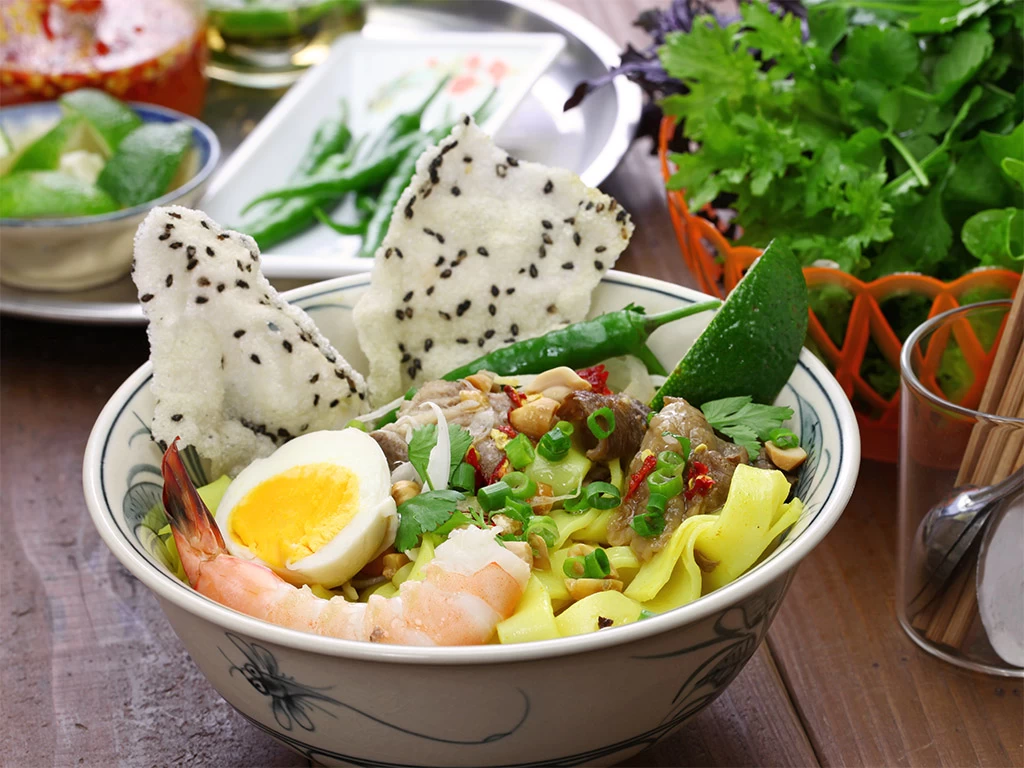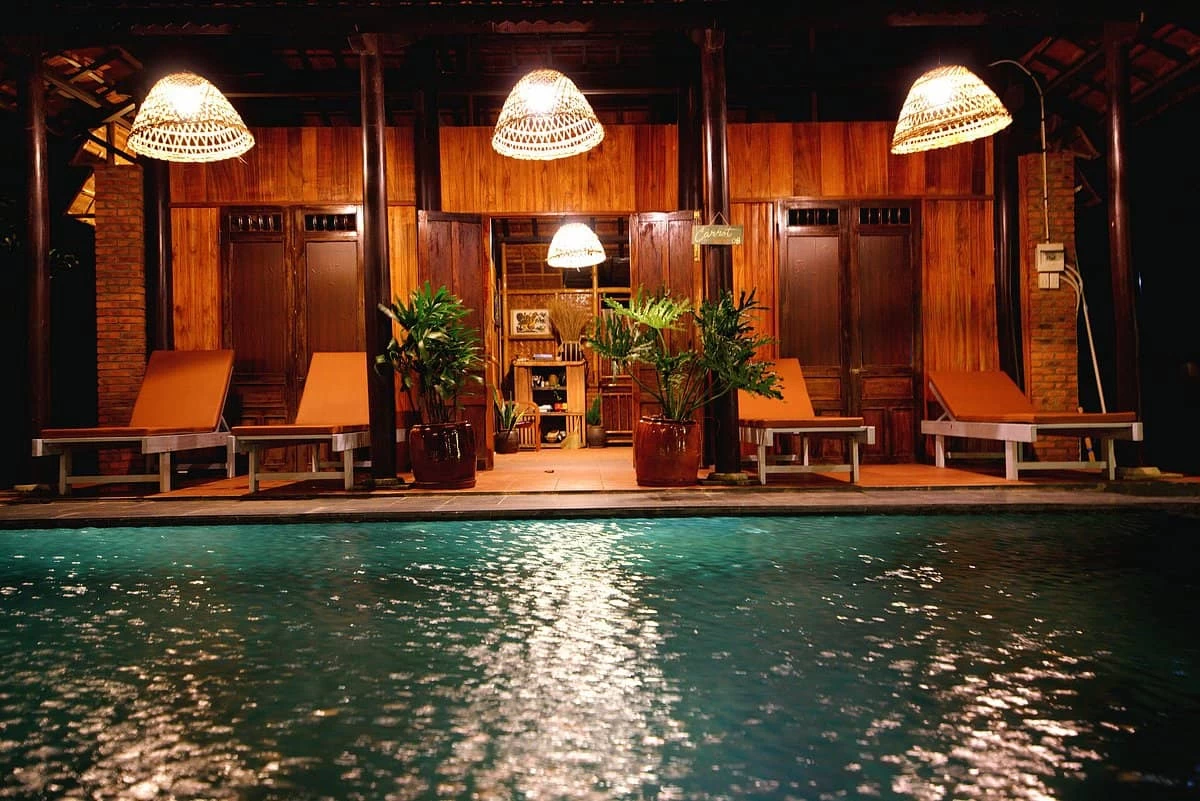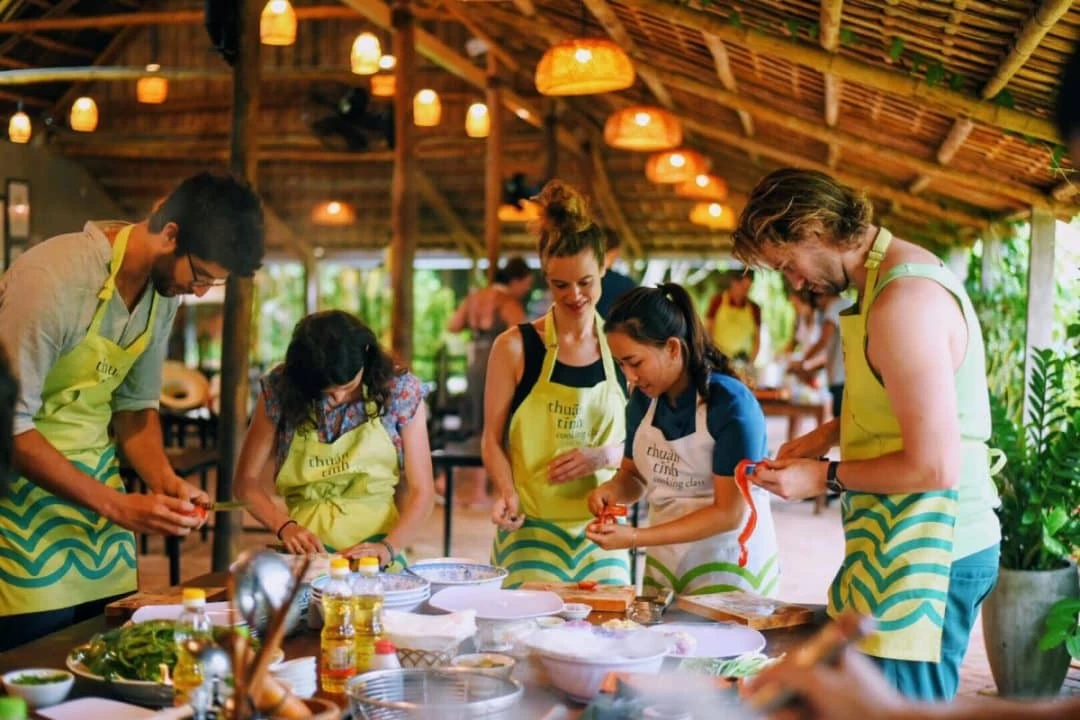
Let’s explore things to do in Hoi An before you go
Discover the best “things to do in Hoi An” with our comprehensive guide! From exploring the ancient town’s iconic landmarks to indulging in local cuisine and participating in traditional handicraft-making classes, plan your perfect trip today with Ula Travel and uncover the charm of Hoi An.
I. Overview of Hoi An
1. Geographic Location and Attractions
Hoi An is a charming and picturesque town located in central Vietnam, on the coast of the East Sea. It is situated in Quang Nam Province, approximately 30 kilometers south of Da Nang. This strategic location makes Hoi An easily accessible by road, rail, and air, with Da Nang International Airport being the nearest major gateway for international travelers.
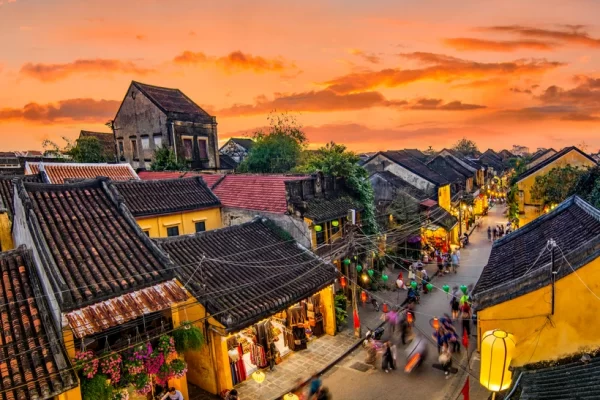
Hoi An is one of UNESCO World Heritage Sites in Vietnam
Hoi An’s allure lies in its well-preserved ancient town, which is a UNESCO World Heritage Site. The town is renowned for its narrow, winding streets lined with traditional wooden houses, ancient temples, and colorful lanterns. The Thu Bon River meanders through the town, adding to its scenic beauty and offering visitors the chance to enjoy leisurely boat rides.
2. History and Unique Culture
Hoi An boasts a rich history that dates back over 2,000 years. Originally, it was a major trading hub from the 15th to the 19th centuries, attracting merchants from China, Japan, India, and Europe. This vibrant trading history has left a lasting impact on Hoi An, creating a unique blend of architectural styles and cultural influences that are still evident today.
Hoi An’s culture is a harmonious mix of indigenous traditions and foreign influences. The town is famous for its traditional craft villages, where visitors can witness artisans creating beautiful lanterns, ceramics, and textiles. The local cuisine is another highlight, offering a delightful fusion of flavors. Must-try dishes include Cao Lau, a noodle dish unique to Hoi An, and Banh Mi (Hoi An Bread), a local delicacy.
II. 7 of the Best Things to Do in Hoi An
1. Walking to Explore the Ancient Town
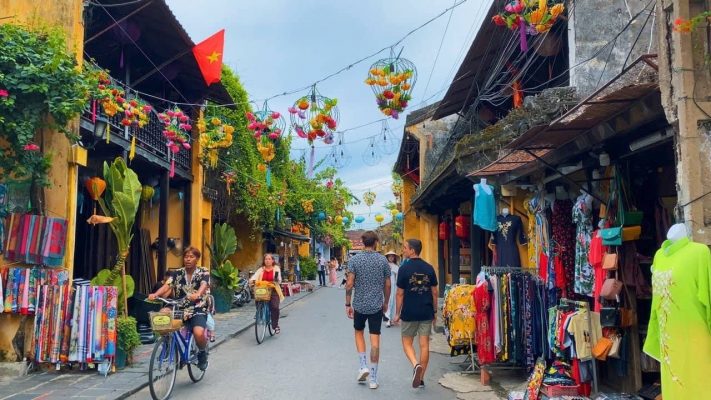
Most tourists walk to see the ancient beauty of Hoi An.
Walking through Hoi An’s ancient town is a delightful experience that allows visitors to immerse themselves fully in its unique charm. The pedestrian-friendly streets make it easy to navigate, and walking provides a closer look at the intricate details of the historic architecture and vibrant daily life. Strolling at your own pace lets you discover hidden gems, interact with friendly locals, and enjoy the atmosphere without the rush.
Highlights to Visit
- Tan Ky Old House: This 200-year-old merchant house is a prime example of Hoi An’s blend of Vietnamese, Chinese, and Japanese architectural styles. Inside, you’ll find antique furniture, intricate carvings, and family heirlooms that tell the story of the merchant family who lived there.
- Japanese Covered Bridge: Built in the early 17th century by the Japanese community, this iconic bridge is a symbol of Hoi An. It features a pagoda and beautiful architectural details, including wooden carvings and a small temple inside.
- Phuc Kien Assembly Hall: Originally a meeting place for the Chinese community, this assembly hall is now a temple dedicated to the sea goddess Mazu. The hall boasts stunning architecture, with intricate woodwork, statues, and a vibrant courtyard.
Are you looking for: All Tours to Hoi An
2. Cycling around Hoi An
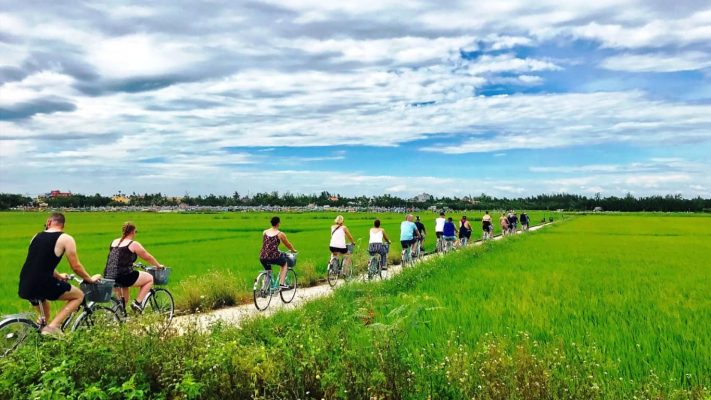
Cycling is a great choice to explore the peaceful beauty of Hoi An.
The Joy of Exploring Hoi An by Bicycle
Cycling is one of the most enjoyable and eco-friendly ways to explore Hoi An. The town’s flat terrain and relatively light traffic make it ideal for biking. Riding a bicycle allows you to cover more ground than walking while still being able to stop and explore whenever something catches your eye. It’s a fantastic way to experience the town’s lush surroundings and scenic beauty at your own pace.
Must-Visit Stops on a Cycling Tour:
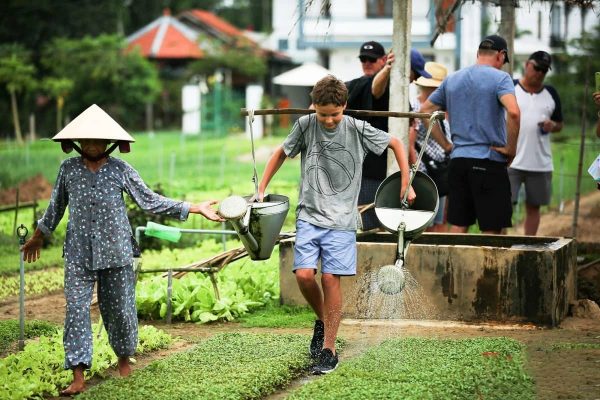
Tra Que Vegetable Village
- Tra Que Vegetable Village: A short ride from the Ancient Town, this village is famous for its organic vegetables and herbs. Visitors can learn about traditional farming techniques, try their hand at gardening, and enjoy fresh, delicious meals made from local produce.

Cam Kim Island- The Green Oasis Of Hoi An
- Cam Kim Island: Just a short ferry ride from Hoi An, Cam Kim Island offers a peaceful escape with its rural landscapes and traditional craft villages. Explore the island to see woodcarvers at work, visit mat-weaving workshops, and enjoy the serene countryside.
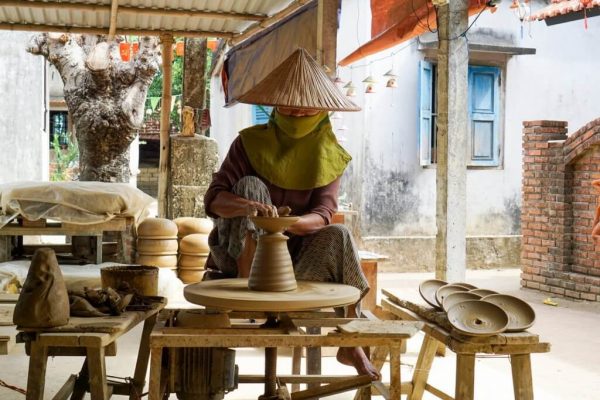
Thanh Ha Pottery Village
- Thanh Ha Pottery Village: Located about 3 kilometers west of Hoi An, this village is known for its centuries-old pottery traditions. Visitors can watch artisans create beautiful pottery items and even try making their own clay creations.
Start your journey with: Vietnam Horizon Hanoi to Hoi An
3. Enjoy the local cuisine.

Hoi A cuisine always attracts tourists from all over.
Hoi An is renowned for its vibrant culinary scene, offering a delightful array of dishes that reflect the rich heritage of the region. Exploring the local cuisine is an essential part of any visit to this charming town, providing an authentic taste of Vietnamese gastronomy. Here are some must-try dishes of Hoi An cuisine:
Must-Try Dishes
- Cao Lau: Originating from Hoi An, Cao Lau is a unique dish featuring thick rice noodles, slices of tender pork, crispy croutons, fresh herbs, and a flavorful broth. Its distinct taste and texture make it a beloved specialty that captures the essence of the region.
- Banh Mi (Hoi An Bread): Hoi An’s take on the iconic Vietnamese sandwich, Banh Mi, is a culinary delight not to be missed. Made with freshly baked baguettes and filled with a variety of ingredients such as savory grilled meats, pâté, pickled vegetables, and herbs, Banh Mi (Hoi An Bread) offers a symphony of flavors and textures in every bite.
- Banh Xeo, a crispy and savory Vietnamese pancake, is another culinary gem of Hoi An. Made with a batter of rice flour, coconut milk, and turmeric and filled with shrimp, pork, bean sprouts, and herbs, Banh Xeo is typically enjoyed wrapped in fresh lettuce leaves with a side of dipping sauce, creating a delightful contrast of flavors and textures.
Let’s explore: Hoi An Cuisine- Top 10 Must-Try Dishes
Why choose Hoi An for a street food tour?
Hoi An is a haven for food enthusiasts. Its vibrant street food scene features a blend of local and international influences, making it a top destination for culinary tours. From bustling night markets to quaint riverside stalls, Hoi An’s food scene is diverse and inviting.
4. Join Hoi An Cooking Classes
Hoi An is renowned for its rich culinary heritage, and participating in a cooking class is a fantastic way to immerse yourself in Vietnamese culture. Here are some of the most popular cooking classes in Hoi An:
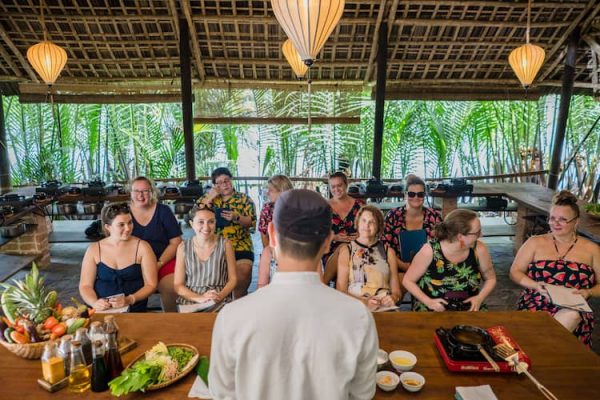
Red Bridge Cooking School
Red Bridge Cooking School: Located along the banks of the Hoi An River, Red Bridge offers a half-day cooking tour that starts with a visit to the local market. You will learn to select fresh ingredients and understand local produce. The class includes hands-on cooking instructions for several traditional dishes and ends with a delicious meal that you have prepared.
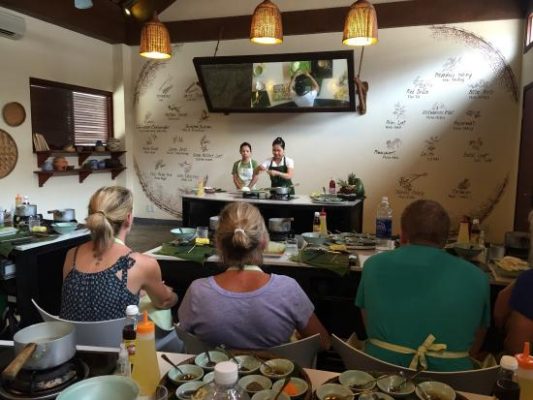
Vy’s Market Restaurant & Cooking School
Vy’s Market Restaurant & Cooking School: This unique cooking school, run by renowned chef Ms. Vy, includes a guided tour of Hoi An’s vibrant food market and an introduction to street food at the school’s own market. You’ll learn to cook several dishes, from appetizers to desserts, and gain insights into Vietnamese culinary techniques and traditions.
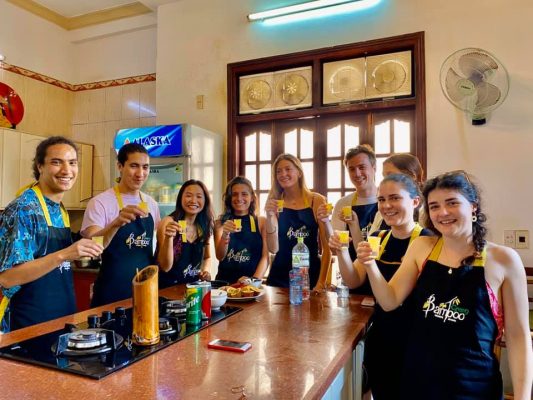
The Green Bamboo Cooking School
The Green Bamboo Cooking School: Chef Van offers a personalized cooking experience with classes that are kept small for individual attention. After a market tour, you’ll cook several Vietnamese dishes of your choice in a homey setting, ensuring a rich and personal learning experience.
Experiencing Traditional Vietnamese Cuisine
Participating in a cooking class in Hoi An allows you to do more than just taste Vietnamese food-you get to create it. Here’s what you can expect from these classes:
- Market Visits: Many classes begin with a tour of the local market, where you’ll learn about the ingredients that form the backbone of Vietnamese cuisine. This is a great opportunity to see and smell the fresh herbs, vegetables, and spices used in traditional dishes.
- Hands-on Cooking: Under the guidance of experienced chefs, you’ll learn to prepare popular Vietnamese dishes such as pho (noodle soup), banh xeo (crispy pancakes), and fresh spring rolls. The hands-on experience ensures that you can recreate these dishes at home.
- Cultural Insights: Cooking classes often include explanations of the cultural significance of certain dishes and cooking techniques. You’ll gain a deeper understanding of Vietnamese traditions and the role of food in daily life.
- Enjoy Your Creations: After cooking, you’ll get to enjoy the fruits of your labor. Sharing a meal with fellow participants adds to the communal and joyful experience of the class.
You will be like: Flavors of Central Vietnam
5. Traditional Handicraft Workshops
Hoi An is famous for its traditional handicrafts, and joining a workshop is an excellent way to learn about and engage with the local culture. Here are some workshops you might consider:
a. Lantern Making Workshops

Hoi An Lantern Making Class
Lanterns are a symbol of Hoi An, and making your own lantern is a wonderful souvenir to take home. Workshops are offered at various studios, including The Lantern Lady and Ha Linh Lanterns. These classes typically guide you through the process of assembling and decorating a lantern, explaining the cultural significance behind each step.
b. Weaving Classes
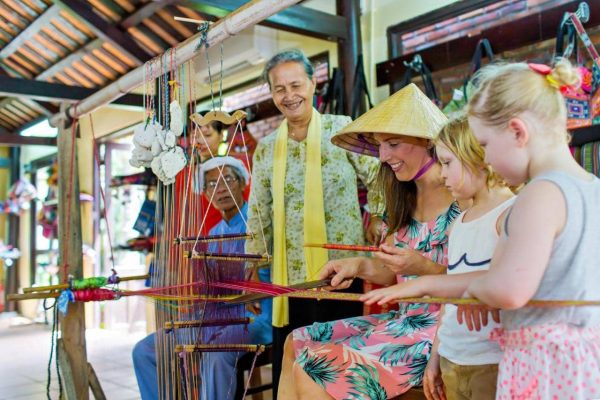
Weaving Classes in Hoi An
The Thanh Ha Terracotta Park offers weaving classes where you can learn traditional weaving techniques from local artisans. You’ll get hands-on experience with a loom and create your own small piece of fabric.
c. Pottery Classes
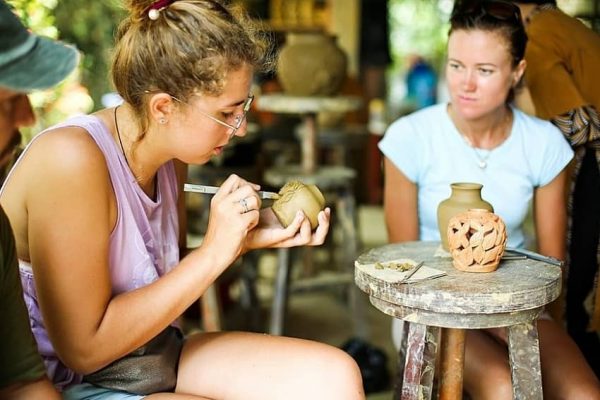
Pottery classes at Thanh Ha Pottery Village
At Thanh Ha Pottery Village, you can try your hand at traditional pottery making. Classes usually involve shaping clay on a wheel and learning about the history and techniques of Vietnamese pottery. You can make your own pots, vases, or sculptures and take them home once they are fired and finished.
Creating and Taking Home Handmade Crafts
Engaging in these workshops allows you to create personalized souvenirs and learn about traditional Vietnamese craftsmanship.
- Hands-on Creation: Whether you are painting a lantern, weaving a piece of fabric, or molding a clay pot, these workshops provide a hands-on experience that is both educational and enjoyable.
- Cultural Connection: By participating in these crafts, you gain a deeper appreciation of the skills and traditions that have been passed down through generations. The artisans often share stories and insights about their craft, adding a rich narrative to your experience.
- Unique Souvenirs: The items you create in these workshops serve as unique, personalized souvenirs. Each piece you make will remind you of your time in Hoi An and the cultural heritage you explored.
6. Visit the local markets.
a. Hoi An Night Market
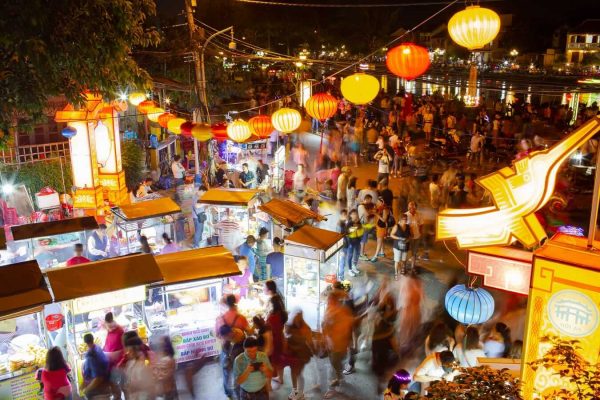
Hoi An Night Market
The Hoi An Night Market is a vibrant and bustling hub of activity, drawing locals and tourists alike with its lively atmosphere and diverse array of stalls. Here, visitors can immerse themselves in the rich tapestry of Vietnamese culture and tradition while indulging in a shopping extravaganza.
- Atmosphere and Unique Stalls: As the sun sets, the streets of Hoi An come alive with colorful lanterns and the sound of laughter and chatter. The night market, located along the picturesque riverside, adds to this enchanting ambiance with its vibrant lights and bustling energy. Strolling through the maze of stalls, visitors will encounter a treasure trove of handicrafts, clothing, accessories, and souvenirs, each exuding its own unique charm and character. From intricately embroidered textiles to handcrafted lanterns and wooden carvings, there is something to captivate every visitor’s imagination.
b. Central Market

Hoi An Night Market
For a more authentic and immersive shopping experience, visitors can venture into the heart of Hoi An’s bustling Central Market. Here, amid the hustle and bustle of local vendors and shoppers, you’ll find an abundance of fresh produce, exotic spices, and tantalizing street food stalls.
- Fresh produce and local products: The Central Market is a paradise for food lovers and culinary enthusiasts, offering a tantalizing array of fresh fruits, vegetables, herbs, and spices sourced directly from local farms and gardens.
- Cultural Experience of Market Shopping: Beyond its culinary delights, the Central Market offers a fascinating glimpse into the everyday lives of the local people and their traditional trading practices. Here, visitors can observe the lively banter between vendors and customers, bargaining over prices and haggling for the best deals.
7. Discover Attractions in Surrounding Areas
a. My Son Sanctuary

My Son Sanctuary
My Son Sanctuary stands as a testament to the rich cultural heritage of Vietnam. Nestled amidst lush greenery, this archaeological site comprises a cluster of ancient Hindu temples and towers dating back to the Champa Kingdom, which flourished between the 4th and 13th centuries.
Recognized as a UNESCO World Heritage Site in 1999, My Son Sanctuary is celebrated for its remarkable architecture, intricate carvings, and spiritual significance, making it a must-visit destination for history enthusiasts and culture seekers alike.
b. Cham Islands

Cham Islands
Island Paradise with Abundant Activities
The Cham Islands, comprising eight picturesque islets located off the coast of Hoi An, beckon travelers with their pristine beauty and diverse array of attractions. Blessed with turquoise waters, sandy beaches, and vibrant coral reefs, these islands offer an idyllic setting for relaxation and adventure.
Visitors to the Cham Islands can indulge in a myriad of activities, from snorkeling and scuba diving to hiking and cultural exploration, promising an unforgettable experience for nature lovers and outdoor enthusiasts.
Activities:
- Snorkeling and Diving: Explore the underwater wonders of the Cham Islands, home to an abundance of marine life and coral formations.
- Fishing and Sailing: Embark on a fishing excursion or enjoy a leisurely boat ride around the islands, immersing yourself in the tranquility of the surrounding seascape.
- Hiking and Trekking: Traverse scenic trails that wind through lush forests and offer panoramic views of the archipelago.
- Cultural Encounters: Engage with local communities and discover the rich heritage of the Cham Islands through visits to traditional villages and historical sites.
c. Bay Mau Coconut Forest

Bay Mau Coconut Forest
Tranquil Retreat Amidst Nature
The Bay Mau Coconut Forest offers a serene escape from the hustle and bustle of urban life. Spanning seven hectares of lush greenery, this ecological haven is situated just a short distance from Hoi An, making it easily accessible for visitors seeking a peaceful retreat in nature.
With its tranquil waterways, verdant coconut groves, and abundant biodiversity, The Bay Mau Coconut Forest provides an ideal setting for eco-friendly adventures and cultural immersion.
Highlights and Experiences:
- Basket Boat Tours: Embark on a leisurely journey through the winding waterways of the coconut forest aboard traditional basket boats. Guided by skilled fishermen, these eco-friendly vessels offer a unique perspective on their natural surroundings.
- Ecological Discoveries: Observe a diverse array of bird species that inhabit the forest canopy and wetland habitats, including kingfishers, egrets, and herons. Learn about the rich biodiversity of the region, which encompasses various plant species, such as mangroves, palms, and orchids, as well as aquatic creatures like fish and crabs.
Do not miss: Colors of Central Vietnam
III. Best Time to Visit Hoi An
Weather Conditions
- Dry Season: From February to August is considered the best time to visit Hoi An due to the dry weather. Rainfall is minimal during these months, making it ideal for outdoor activities and sightseeing.
- Wet Season: The wet season lasts from September to January, with heavy rainfall and occasional flooding. Travelers should be prepared for rain and consider indoor activities during this time.
Peak and Off-Peak Seasons
- Peak Season: The peak tourist season in Hoi An typically coincides with the dry season, especially from February to April and from June to August. During these months, the city can be crowded, and accommodation prices may be higher.
- Off-Peak Season: The wet season, from September to January, is considered the off-peak season. Travelers visiting during this time can enjoy fewer crowds and lower prices for accommodations and tours. However, they should be prepared for rain and potential flooding.
In summary, Hoi An’s geographic location, historical significance, and rich cultural heritage make it a must-visit destination for travelers from around the world. Whether strolling through its ancient streets, savoring local delicacies, or participating in traditional crafts, visitors are sure to be captivated by the unique charm and timeless beauty of Hoi An.
See more: Vietnam Travel Tips



